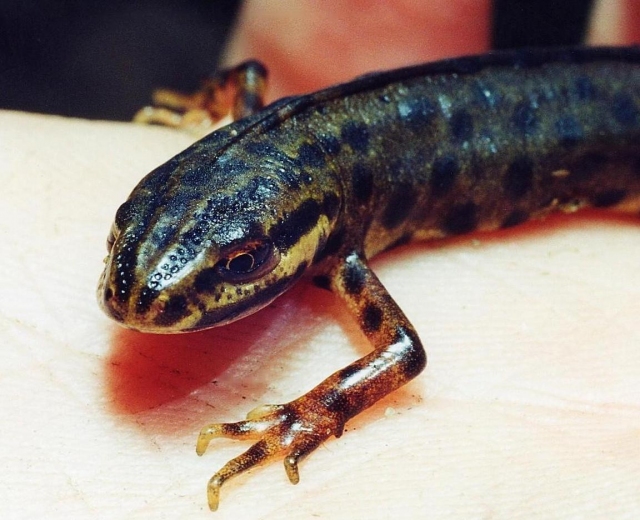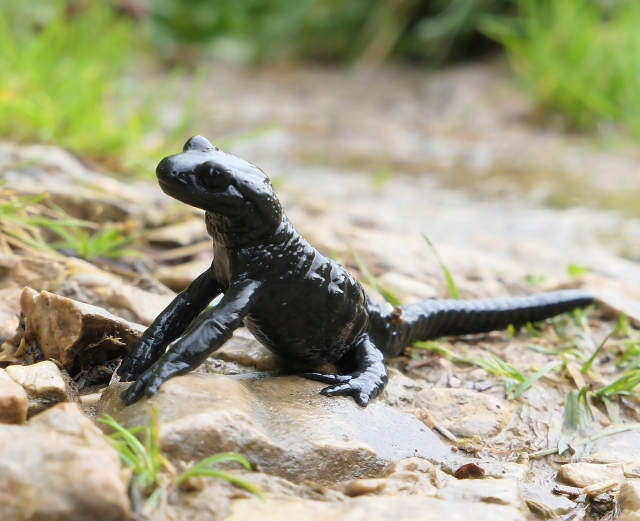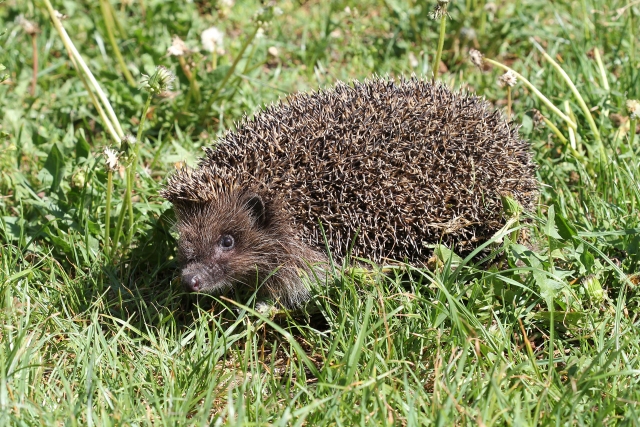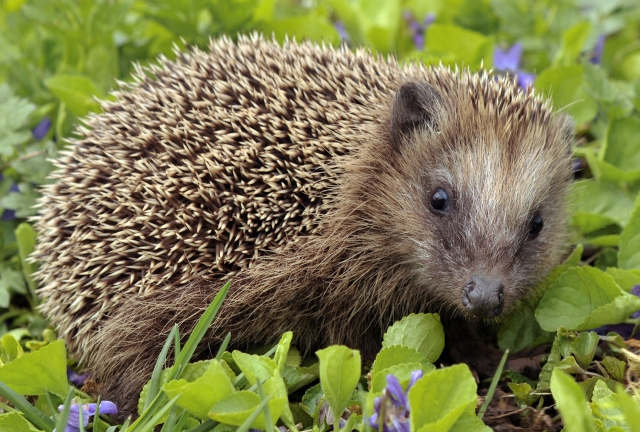Florian Heigl
Alpine newt
Description
During the mating season in spring, the males, up to nine cm long, have a blue dorsal colouration; their flanks are spotted black and white and bordered by a blue stripe towards the belly. The flat, straight (not serrated) dorsal crest is alternately yellowish-black spotted. The females, up to twelve cm long, are dark grey-brown-greenish marbled in aquatic habitat and show somewhat weaker flank spotting. The central ventral side of both sexes is bright orange to cinnamon red in colour and - in contrast to other newt species - usually unspotted. After the end of the spawning season in May, the adults leave the water again and gradually develop a more inconspicuous land costume. This is characterised by a dark, almost black, granulated, dull and water-repellent skin on top. The belly remains slightly orange, but is less colourful than in the aquatic display.
Habitat
The Alpine newt is a typical inhabitant of water-rich forests in hilly to mountainous landscapes - it is often associated with the palmate newt, which is, however, rarer overall. It is usually absent in sparsely wooded areas. In addition to dense deciduous forests, it also inhabits park-like areas and semi-natural gardens. Outside the spawning season, the Alpine Newt is a nocturnal land animal. During the day it hides in many shady places, for example under stones or wood. At night, it hunts for beetles, earthworms and other small animals. Its main enemies are trout, other fish and larvae of the blue-green damselfly, which prey mainly on newt larvae. After "awakening" from their winter torpor in February/March, Alpine newts immediately migrate to nearby bodies of water - especially forest ponds and lakes, firewater ponds, wildlife ponds and water-filled wagon tracks on forest roads. These may well be cool, shady and devoid of vegetation.
The text is a translation of an excerpt from Wikipedia (https://de.wikipedia.org/wiki/Bergmolch). On wikipedia the text is available under a „Creative Commons Attribution/Share Alike“ licence. Status: 29 June 2021
Danube crested newt
Description
The Danube crested newt is a rather graceful, slender newt compared to other crested newts. At 12-14 (males) or 13-16 cm (females) in total length, the species remains slightly smaller than the other crested newt species; in addition, its limbs are relatively short. The dorsal colouration is often brown rather than blackish with round, dark spots; males from the Danube Delta also show a brick-red dorsal colour. As in Triturus cristatus, there are some white spotted areas on the coarsely granulated flanks. Females sometimes have an orange-yellow longitudinal line on the back. The ventral side is orange-red to yolk-yellow and patterned with smaller, sharply defined dark spots, which may also merge to form longitudinal bands. The throat and the head area are grey to black and covered with white spots.
During the mating season, the males develop a particularly high, deeply serrated, flexible dorsal crest. At the root of the tail, this is separated from the skin edges of the ruddy tail, although not always as clearly as in other great crested newts. The dorsal and caudal crests are regressed in the terrestrial habitat.
Habitat
The Danube crested newt prefers terrestrial habitats with riparian forests and structurally rich forest edges near spawning waters. For breeding, the species needs standing waters with shallow zones, which are as free of fish as possible.
The text is a translation of an excerpt from Wikipedia (https://de.wikipedia.org/wiki/Donau-Kammmolch). On wikipedia the text is available under a „Creative Commons Attribution/Share Alike“ licence. Status: 29 June 2021
Italian crested newt
Description
It is a broad-headed, quite large newt. It reaches similar body lengths to the Northern crested newt (Triturus cristatus) - on average about 12 to 13 cm; in females at most over 20 cm. During the mating season, the males develop a dorsal crest that is not as high or as strongly serrated as in the Northern crested newt or the Danube crested newt. The dorsal crest is separated from the caudal margin by an incision - as in all crested newts (but compare: common newt). The upperpart appears light brownish-grey to dark brown, with dark round spots and is relatively smooth-skinned. Females in terrestrial display and juveniles often have a yellowish longitudinal line on the back. The throat is white spotted, the belly yellow or orange with dark, particularly "washed out" looking, not sharply defined spots. In contrast to the other crested newt species, the flanks are barely spotted with white. Especially the washed-out spotting and the lack of white dotting on the sides are considered the most important external identification features.
Habitat
During the mating season in spring and sometimes also during the summer, the animals stay in perennial, herbaceous pools and ponds. Crested newts in general are more seasonally bound to the water body than other newts.
The text is a translation of an excerpt from Wikipedia (https://de.wikipedia.org/wiki/Alpen-Kammmolch). On wikipedia the text is available under a „Creative Commons Attribution/Share Alike“ licence. Status: 29 June 2021
Northern crested newt
Description
The Northern crested newt is a rather large, powerful newt with a broad head. The males reach a length of ten to a maximum of 18 cm, the females from eleven to a maximum of 20 cm. The upperparts are grey-black in colour, with indistinct darker spots or patches; the skin appears slightly warty-grained. The flanks are intensely whitish granulated at the transition to the ventral side. The belly is yellow or orange with black spots. This pattern of spots even makes it possible to distinguish the animals individually in field biology studies. During the mating season, males develop a high, strongly serrated skin crest on the back and tail, which is interrupted at the root of the tail (in contrast to the common newt). Males also have a characteristic pearly-silvery band ("milk stripe") on the sides of the tail and a more bulging, black cloaca. The females have only a low caudal fin fringe. Their orange belly colouring continues over the cloaca on the lower edge of the tail. After spending time in the water, the aquatic display, especially the conspicuous skin fringes of the males, is largely regressed in late summer, giving way to a more inconspicuous terrestrial display.
Habitat
Spawning waters are mostly perennial, i.e. permanently water-bearing small ponds and pools in rather loamy, rarely sandy soils, which are exposed to sunlight for at least several hours a day. They often have both an open water zone and a richly weedy reed and submerged vegetation and are eutrophic (but not excessively eutrophic!). As this structure is also preferred by other amphibians, water bodies where the Northern crested newt occurs are often characterised by particularly species-rich amphibian communities (associations of different species).
In the vicinity of the water bodies, suitable terrestrial habitats must be available in good spatial interlocking, for example grassland interspersed with field copses, fens, deciduous forests and fringe biotopes such as riparian strips, hedges and similar. Sometimes very valuable habitat structures develop in abandoned soil mining pits. The animals like to seek shelter under stones and lying deadwood and spend the day resting there.
The text is a translation of an excerpt from Wikipedia (https://de.wikipedia.org/wiki/Nördlicher_Kammmolch). On wikipedia the text is available under a „Creative Commons Attribution/Share Alike“ licence. Status: 29 June 2021
Common newt
Description
The common newt is a small caudate with a maximum body length of 11 cm (less in southern Europe). The upperparts are with smooth skin and yellow-brown to black-grey colouration. The males have coarse, roundish, dark spots on it - especially conspicuous during the mating season. Both sexes have alternating light and dark stripes on the sides of the head (hence the name "striped newt"); there are three longitudinal furrows on the upperpart (compare cover photo). The underpart is orange in the middle, becoming lighter towards the sides and also with dark markings - in the males these are large dots, in the females fine spots.
In their aquatic phase, the males develop a high, wavy to serrated (in southern subspecies also smooth-edged), flexible skin crest, which - in contrast to the great crested newt - runs from the back of the head to the end of the tail without an indentation at the root of the tail. Their fin seam on the underpart of the laterally flattened tail shows a bluish tinge. The hind feet show blackish swimming fringes at this stage. The cloaca of males is much more prominent and darker in colour than that of females. The females look much more inconspicuous overall and usually have a slightly lighter, rather brownish basic colouration. For the non-expert, they are difficult to distinguish from those of the palmate newt. Among other things, however, the throat is usually also spotted, in contrast to that of the palmate newt. In addition, yellow pads can be seen under the soles of the feet of female newts, which are usually absent in common newts. In the terrestrial habitat, the skin becomes dry, fine-grained and water-repellent; the colouration is now very muted.
Habitat
The common newt prefers semi-open to open landscapes, but does not completely avoid densely forested mountainous regions. In such areas, however, the Italian crested newt and, especially in the west, the palmate newt are found much more frequently. In the lower altitudes of Central Europe, the common newt is by far the most common caudate and, along with the common toad and the grass frog, one of the still almost ubiquitous amphibian species. During "toad migration" campaigns along roads to protect migrating amphibians, it is not uncommon for hundreds, in extreme cases even several thousand common newts to be registered.
Land habitats include grassland areas with hedges, forest edges, semi-natural gardens and parks, abandoned gravel pits and the banks of water bodies. The common newt is considered a very adaptable amphibian and a synanthropic species. It feeds on insects, worms and other small animals at night; during the day and in dry periods it hides under stones, leaves or roots. In spring and early summer, it feeds mainly on small crustaceans, but also on frogspawn, tadpoles and even eggs and larvae of its own species. Smaller, at least temporarily sunny pools, ponds and ditches with rich underwater weeds are preferred as spawning waters. Thanks to their tail, the newts move as swiftly as fish under water. They regularly swim to the surface to gasp for air. In case of danger, they flee in a flash to the bottom of the water or between water plants. By July, most common newts have left the water to live on land. Some, however, remain more or less permanently aquatic (compare: Northern crested newt). In October or November (Central Europe), the animals retreat to frost-proof terrestrial shelters; some also hibernate in the water.
The text is a translation of an excerpt from Wikipedia (https://de.wikipedia.org/wiki/Teichmolch). On wikipedia the text is available under a „Creative Commons Attribution/Share Alike“ licence. Status: 29 June 2021
Alpine salamander
Description
The males of the Alpine salamander remain on average slightly smaller than the females, which grow up to about 15 cm long. On average, the animals grow to a length of 11-12 cm.
The animals are uniformly black in colour and appear somewhat less stocky than fire salamanders (Salamandra salamandra). When healthy, the animals are shiny. The underparts are lead-grey and a longitudinal groove runs down to the tail. The male can be distinguished from the female externally by a slightly more protruding cloaca.
The black eyes and the prominent ear glands (paratoid glands) are clearly visible on the head, which is broader than long and has a rounded snout. Along the flanks of the body, the animals have a series of warty and roundish elevations containing glandular exits. The trunk is segmented laterally by eleven to thirteen costal furrows. The tail is not as long as the trunk and is almost quadrangular in cross-section; it ends relatively pointed.
Habitat
The habitats of the Alpine salamander include karst areas and high mountain ravines. In the Alps, it usually occurs from altitudes of 1000 m, regionally also from 800 m; only rarely are specimens found at lower altitudes. Sometimes such finds can also be due to the drifting of animals with torrential streams. Predominantly moist deciduous and mixed mountain forests near mountain streams are colonised, above the tree line biotopes such as moist alpine pastures, dwarf shrub heaths and scree slopes. Here the Alpine salamander can be found under stones or deadwood.
Favourable habitats for dense populations are stabilised boulder and scree slopes, greasy meadows, forest edges and mountain forests. Within the forests, pure coniferous forest areas are rather avoided, deciduous-coniferous mixed forests and especially deciduous forest areas are preferred. The highest densities are found along small forest streams or in spray zones at the foot of waterfalls. Ravines also offer good living conditions.
The Alpine salamander tends to occur at sites with a basic soil reaction and high pH values. This also explains why sites with acidic soil reaction are problematic for it. This also explains why it occurs more frequently in deciduous forests than in coniferous forests with low pH values. Fertilisation has a positive effect on its occurrence, as fat meadows are moister than lean meadows. The Alpine salamander is site-faithful; its habitat is only a few square meters in size.
The text is a translation of an excerpt from Wikipedia (https://de.wikipedia.org/wiki/Alpensalamander). On wikipedia the text is available under a „Creative Commons Attribution/Share Alike“ licence. Status: 29 June 2021
Northern white-breasted hedgehog
Description
It differs from the European hedgehog mainly in the lighter colouring of the chest, which stands out clearly from the brown or brown-grey surroundings. The pale sections of the underpart are almost white, and the middle of the chest is always white. The back and the top of the head are covered with spines. If attacked, it can curl up into a ball.
Habitat
The Northern white-breasted hedgehog inhabits farmland, parks and gardens in rural and urban areas, and moderately overgrown forest edges. Like the related European hedgehogs, the Northern white-breasted hedgehog is a synanthropic species and occurs more frequently in cultivated landscapes rather than natural environments. The animals are nocturnal solitary animals, spending the day in a nest to forage at night. Their diet consists mainly of insects, earthworms, millipedes and ants.
The text is a translation of an excerpt from Wikipedia (https://de.wikipedia.org/wiki/Nördlicher_Weißbrustigel). On wikipedia the text is available under a „Creative Commons Attribution/Share Alike“ licence. Status: 22 July 2021
European hedgehog
Description
The most striking feature of the European hedgehog are the spines that cover the top of the head and the back. European hedgehogs have short limbs, with the hind limbs being slightly longer than the front limbs. Each foot ends in five toes, which are provided with claws. The second, third and fourth toes are approximately the same length, the first and fifth are smaller and also have smaller claws. The head of the European hedgehog has a long, mobile snout. The eyes are round and small, the ears are also small with a length of one cm and almost completely hidden in the fur.
Habitat
European hedgehogs prefer a richly structured field with a varied vegetation of hedges, bushes, ground covers, pastures, field margins with old grass or shrub thickets, small woody plants with dead wood and ruderal areas. They can also be found at the edges of deciduous forests. They avoid coniferous forests, treeless and shrubless agricultural areas and excessively wet habitats such as bogs. Bushes and hedges, but also hollow tree trunks and rock crevices serve them as resting places. Sometimes they also occupy abandoned burrows of other mammals. Today, European hedgehogs are mainly found in meadow orchards, near-natural gardens, parks and cemeteries, as well as in green settlements on the outskirts of towns and villages. They have been able to compensate for the loss of their original habitat - namely a richly structured field landscape - at least in part by increasingly entering the human settlement area as synanthropic species.
The text is a translation of an excerpt from Wikipedia (https://de.wikipedia.org/wiki/Braunbrustigel). On wikipedia the text is available under a „Creative Commons Attribution/Share Alike“ licence. Status: 22 July 2021
Crowned shrew
Description
The crowned shrew is very similar to the Eurasian shrew in size and colouration, a reliable differentiation is only possible on the basis of certain measuring sections on the lower jaw as well as on biochemical and chromosomal characteristics. The snout-vent length is up to 79 mm, the tail length up to 47 mm and the weight up to 9.8 g. Like the Eurasian shrew, the upperparts are blackish brown, the flanks are light brown and the underparts are grey.
Habitat
Like the Eurasian shrew, the crowned shrew inhabits woods, hedgerows, extensively used meadows and edges of wetlands.
The text is a translation of an excerpt from Wikipedia (https://de.wikipedia.org/wiki/Schabrackenspitzmaus). On wikipedia the text is available under a „Creative Commons Attribution/Share Alike“ licence. Status: 06 August 2021
Eurasian shrew
Description
The snout-vent length is 65 to 85 mm, the tail length 35 to 47 mm and the weight 6.5 to 14.3 g. The upperparts are blackish brown, the flanks are light brown and the underpart is grey. In young animals the upperparts are lighter and the transition to the light flank colouration is smooth.
The closely related crowned shrew, which is also widespread in western Central Europe, is slightly smaller on average. The dark brown colouration on the back is usually narrower and contrasts more clearly with the light brown colouration on the flanks. In both species, however, the body size and colouration of the specimens varies considerably and so there are ultimately no reliable external distinguishing characteristics. They can only be identified by genetic examination and minor differences in the skeletonised skull. The Eurasian pygmy shrew is smaller, the upperpart colouration is not clearly bicoloured, but grey-brown, the tail is proportionally longer and quite conspicuously thickened. Their eyes are proportionally even smaller.
The Alpine shrew, Eurasian water shrew and Mediterranean water shrew have black to black-grey fur, the latter two species are also significantly larger and stronger. The only distantly related native white-toothed shrews, i.e. the bicoloured shrews, European white-toothed shrews and lesser white-toothed shrews, differ from the Eurasian shrew, among other things, in that their auricles are not covered by hair, the tips of their teeth are white instead of dark brown, and there are occasional long, protruding hairs on their tails.
Habitat
The Eurasian shrew reaches its highest densities in damp forests and wet meadows, but also inhabits almost all other terrestrial habitats, including rock crevices and sand dunes.
The text is a translation of an excerpt from Wikipedia (https://de.wikipedia.org/wiki/Waldspitzmaus). On wikipedia the text is available under a „Creative Commons Attribution/Share Alike“ licence. Status: 06 August 2021










